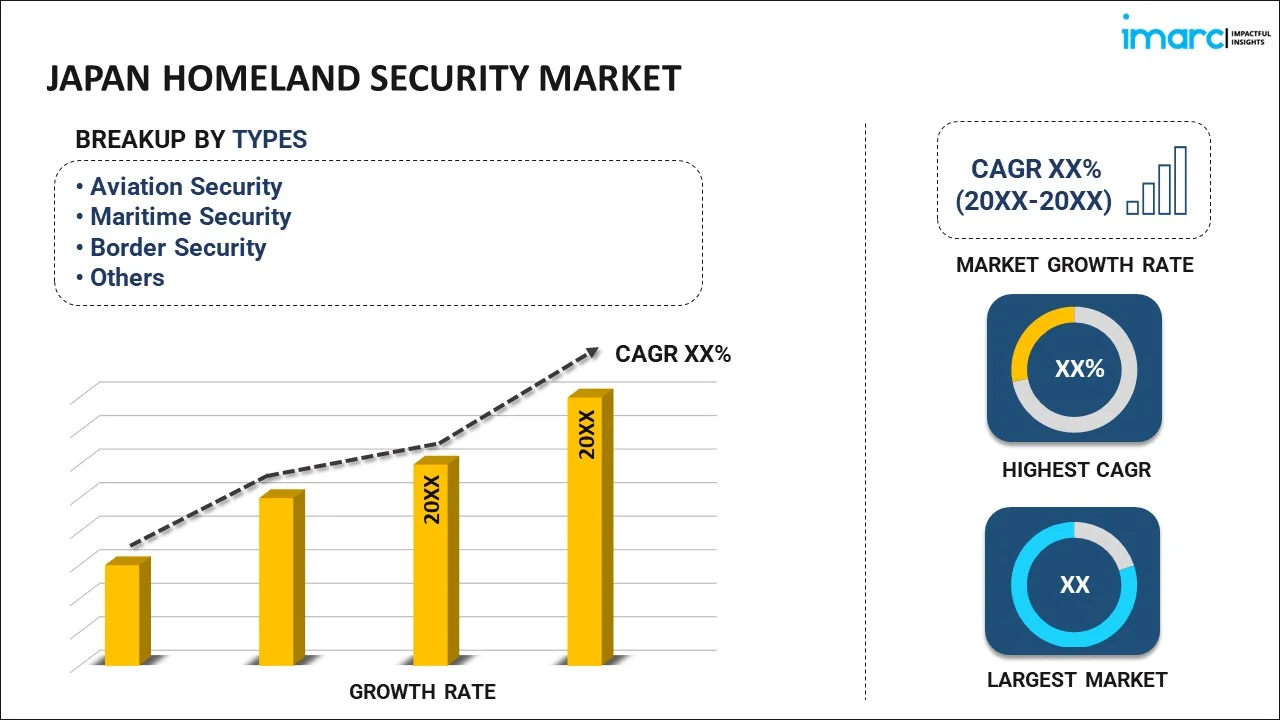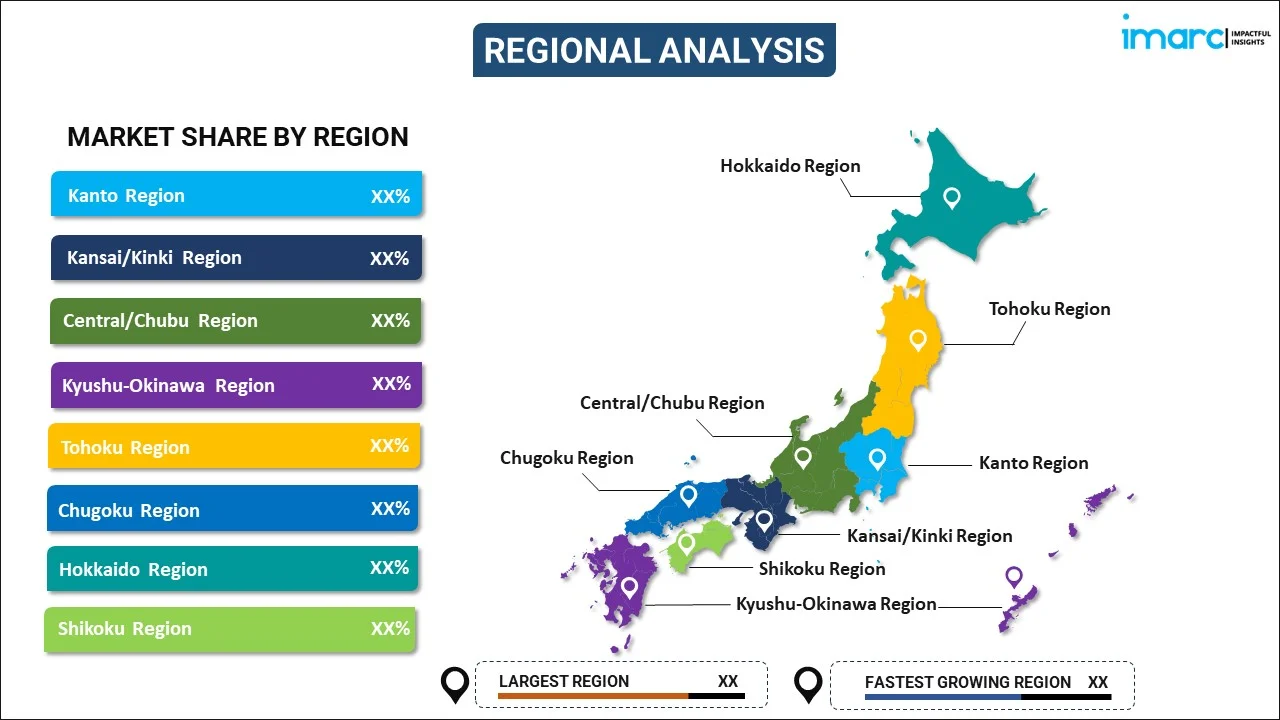
Japan Homeland Security Market Report by Type (Aviation Security, Maritime Security, Border Security, Critical Infrastructure Security, Cyber Security, CBRN Security, Mass Transit Security, and Others), System (Intelligence and Surveillance System, Detection and Monitoring System, Weapon System, Access Control System, Modelling and Simulation, Communication System, Platforms, Rescue and Recovery System, Command and Control System, Countermeasure System, and Others), End User (Public Sector, Private Sector), and Region 2025-2033
Market Overview:
Japan homeland security market size reached USD 38.1 Billion in 2024. Looking forward, IMARC Group expects the market to reach USD 60.1 Billion by 2033, exhibiting a growth rate (CAGR) of 5.2% during 2025-2033. The heightened geopolitical tensions among neighboring countries, an evolving cyber threat landscape nationwide, a rising focus on disaster management, and favorable government policies and technological advancements represent some of the key factors driving the market.
|
Report Attribute
|
Key Statistics
|
|---|---|
|
Base Year
|
2024 |
|
Forecast Years
|
2025-2033 |
|
Historical Years
|
2019-2024
|
| Market Size in 2024 | USD 38.1 Billion |
| Market Forecast in 2033 | USD 60.1 Billion |
| Market Growth Rate (2025-2033) | 5.2% |
Homeland security refers to the collective efforts and strategies aimed at ensuring the safety, security, and resilience of a nation against both internal and external threats. This domain is primarily focused on preventing and responding to terrorist attacks and threats that could potentially harm national security. Homeland security is usually a governmental responsibility involving various agencies and departments that work in tandem to safeguard the nation from a multitude of risks, such as terrorism, natural disasters, cyber threats, and pandemics. Technological advancements play a significant role in modern homeland security efforts. Tools like biometric identification, advanced surveillance systems, and data analytics are actively being used to monitor and respond to risks more efficiently. International collaboration has also become essential, as threats to national security are increasingly global in nature. Information sharing, joint operations, and diplomatic initiatives with allied nations contribute to a more comprehensive approach to homeland security. As a result, homeland security serves as an integrated approach to protect a nation’s territory and citizens from various forms of threats and risks.
Japan Homeland Security Market Trends:
The Japan homeland security market is currently experiencing growth propelled by several key factors. One of the key drivers is the country’s geopolitical landscape, which includes concerns about regional stability. The nation’s proximity to North Korea and ongoing territorial disputes with countries like China and Russia are compelling Japan to invest heavily in strengthening its homeland security measures, thus fueling market growth. Additionally, the evolving nature of threats, including cyber-attacks and domestic terrorism, represents another major growth-inducing factor. As a technologically advanced nation, Japan is continuously facing the risk of cyber threats, impacting both government institutions and private sectors. Consequently, the rising investment in cybersecurity to mitigate these risks is contributing to the market growth. The country is also looking to upgrade its disaster management capabilities as it is prone to natural calamities such as earthquakes, tsunamis, and typhoons, accelerating the adoption of homeland security measures. Past disasters, like the 2011 Fukushima incident, have led to a heightened focus on improving disaster response mechanisms, including early warning systems and crisis management centers, further driving market growth. Moreover, as Japan prepares for major global events such as the previously postponed Tokyo Olympics, there has been a rise in the need for ensuring the security of critical infrastructure like transportation systems, stadiums, and communication networks. This has led to a growing emphasis on deploying state-of-the-art surveillance systems and implementing rigorous security protocols. Besides this, ongoing technological advancements are also playing a role in positively influencing market growth. Japan is a leader in technology innovation, and the application of advanced technologies like Artificial Intelligence (AI), biometrics, and drones in the field of homeland security is gaining prominence. These technologies enhance the capabilities of law enforcement agencies, border control, and other security services, making them more efficient and effective. Furthermore, Japan’s government is allocating significant budgets and passing legislation aimed at strengthening national security, thus favoring market growth.
Japan Homeland Security Market Segmentation:
IMARC Group provides an analysis of the key trends in each segment of the market, along with forecasts at the country level for 2025-2033. Our report has categorized the market based on type, system, and end user.
Type Insights:

- Aviation Security
- Maritime Security
- Border Security
- Critical Infrastructure Security
- Cyber Security
- CBRN Security
- Mass Transit Security
- Others
The report has provided a detailed breakup and analysis of the market based on the type. This includes aviation security, maritime security, border security, critical infrastructure security, cyber security, CBRN security, mass transit security, and others.
System Insights:
- Intelligence and Surveillance System
- Detection and Monitoring System
- Weapon System
- Access Control System
- Modelling and Simulation
- Communication System
- Platforms
- Rescue and Recovery System
- Command and Control System
- Countermeasure System
- Others
A detailed breakup and analysis of the market based on the system have also been provided in the report. This includes intelligence and surveillance system, detection and monitoring system, weapon system, access control system, modelling and simulation, communication system, platforms, rescue and recovery system, command and control system, countermeasure system, and others.
End User Insights:
- Public Sector
- Private Sector
The report has provided a detailed breakup and analysis of the market based on the end user. This includes public sector and private sector.
Regional Insights:

- Kanto Region
- Kansai/Kinki Region
- Central/ Chubu Region
- Kyushu-Okinawa Region
- Tohoku Region
- Chugoku Region
- Hokkaido Region
- Shikoku Region
The report has also provided a comprehensive analysis of all the major regional markets, which include Kanto Region, Kansai/Kinki Region, Central/ Chubu Region, Kyushu-Okinawa Region, Tohoku Region, Chugoku Region, Hokkaido Region, and Shikoku Region.
Competitive Landscape:
The market research report has also provided a comprehensive analysis of the competitive landscape. Competitive analysis such as market structure, key player positioning, top winning strategies, competitive dashboard, and company evaluation quadrant has been covered in the report. Also, detailed profiles of all major companies have been provided.
Japan Homeland Security Market Report Coverage:
| Report Features | Details |
|---|---|
| Base Year of the Analysis | 2024 |
| Historical Period | 2019-2024 |
| Forecast Period | 2025-2033 |
| Units | Billion USD |
| Scope of the Report | Exploration of Historical and Forecast Trends, Industry Catalysts and Challenges, Segment-Wise Historical and Predictive Market Assessment:
|
| Types Covered | Aviation Security, Maritime Security, Border Security, Critical Infrastructure Security, Cyber Security, CBRN Security, Mass Transit Security, Others |
| Systems Covered | Intelligence and Surveillance System, Detection and Monitoring System, Weapon System, Access Control System, Modelling and Simulation, Communication System, Platforms, Rescue and Recovery System, Command and Control System, Countermeasure System, Others |
| End Users Covered | Public Sector, Private Sector |
| Regions Covered | Kanto Region, Kansai/Kinki Region, Central/ Chubu Region, Kyushu-Okinawa Region, Tohoku Region, Chugoku Region, Hokkaido Region, Shikoku Region |
| Customization Scope | 10% Free Customization |
| Post-Sale Analyst Support | 10-12 Weeks |
Delivery Format |
PDF and Excel through Email (We can also provide the editable version of the report in PPT/Word format on special request) |
Key Questions Answered in This Report:
- How has the Japan homeland security market performed so far and how will it perform in the coming years?
- What has been the impact of COVID-19 on the Japan homeland security market?
- What is the breakup of the Japan homeland security market on the basis of type?
- What is the breakup of the Japan homeland security market on the basis of system?
- What is the breakup of the Japan homeland security market on the basis of end user?
- What are the various stages in the value chain of the Japan homeland security market?
- What are the key driving factors and challenges in the Japan homeland security?
- What is the structure of the Japan homeland security market and who are the key players?
- What is the degree of competition in the Japan homeland security market?
Key Benefits for Stakeholders:
- IMARC’s industry report offers a comprehensive quantitative analysis of various market segments, historical and current market trends, market forecasts, and dynamics of the Japan homeland security market from 2019-2033.
- The research report provides the latest information on the market drivers, challenges, and opportunities in the Japan homeland security market.
- Porter's five forces analysis assist stakeholders in assessing the impact of new entrants, competitive rivalry, supplier power, buyer power, and the threat of substitution. It helps stakeholders to analyze the level of competition within the Japan homeland security industry and its attractiveness.
- Competitive landscape allows stakeholders to understand their competitive environment and provides an insight into the current positions of key players in the market.
Need more help?
- Speak to our experienced analysts for insights on the current market scenarios.
- Include additional segments and countries to customize the report as per your requirement.
- Gain an unparalleled competitive advantage in your domain by understanding how to utilize the report and positively impacting your operations and revenue.
- For further assistance, please connect with our analysts.
 Inquire Before Buying
Inquire Before Buying
 Speak to an Analyst
Speak to an Analyst
 Request Brochure
Request Brochure
 Request Customization
Request Customization




.webp)




.webp)












